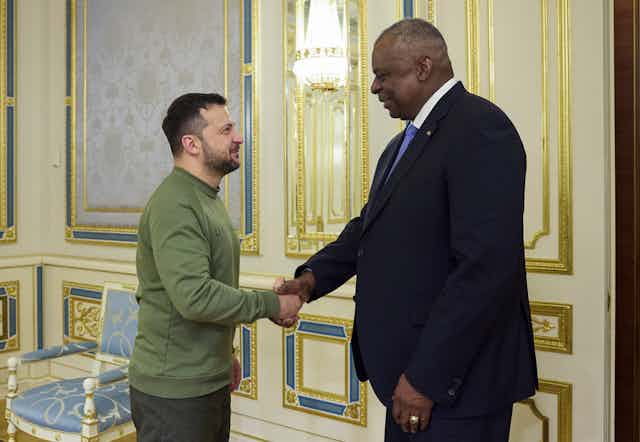US president Joe Biden took to the pages of the Washington Post last week to assure the American people that continuing economic and military support to Ukraine is an investment in US security. On October 20, the US defence secretary, Lloyd Austin, visited Kyiv to give the Ukrainian leadership a similar assurance together with the promise of an additional US$100 million (£80 million) in military aid.
A day later, his German counterpart, Boris Pistorius, announced a new €1.3 billion (£1.1 billion) support package, focused on defensive equipment including four more IRIS-T SLM air defence systems and anti-tank mines.
This is an indication of a growing realisation that western emphasis is shifting to sustaining Ukraine’s defence against Russian aggression – contrary to the insistence by Ukrainian president, Volodymyr Zelensky and his closest political allies that victory on the battlefield is not just possible but probable. This view is now even contested in Kyiv.
In an interview with The Economist, Ukraine’s commander-in-chief, Valerii Zaluzhnyi, said: “There will most likely be no deep and beautiful breakthrough.” The US defence secretary echoed this view in Kyiv, emphasising that Ukraine needs to “make the right adjustments” to its strategy.
Similar doubts have been voiced in western capitals for months. In July 2023, the then chairman of the joint chiefs of staff, General Mark Milley, warned that that Ukraine’s counteroffensive, then in its fourth week, would be “very long” and “very, very bloody”.
Less than two weeks later, a Nato communique after its summit in Vilnius [failed to provide] more than the vague promise of future membership. The next day, the G7 leaders’ joint declaration of support for Ukraine noted that G7 members were launching negotiations on “bilateral, long-term security commitments and arrangements” to support Ukraine.
There are further sobering signs of a significant reset of western strategy on Ukraine. An article in Time magazine painted a bleak picture of deliberations in Zelensky’s inner circle over how difficult the war will be to win.
Meanwhile, an NBC story revealed mounting western pressure on Ukraine to consider a peace deal with Russia that would involve at least some territorial concessions.
No appetite for endless conflict
The underlying premise of this reset in western attitudes is that the outcome of this war will ultimately not be decided for a long time.
Bilateral security guarantees – especially from the US, UK, Germany and France – would go some way in assuring Ukraine that the west would continue to have its back while kicking the thorny issue of Nato membership into the long grass.
The west could also remain rhetorically committed to Zelensky’s peace formula. And support for EU membership – likely to be a long and slow process – could also continue and assist Ukraine with both reforms and recovery. Such an approach would anchor Ukraine more clearly in the west in ways that might be less unacceptable to Russia than Nato membership.

Stalemate reached?
All of this, however, is predicated on the assumption of a stalemate on the ground, which Moscow and Kyiv would need to accept. It also assumes that neither side can see a clear opportunity to either escalate militarily to victory or do enough to have the advantage should the two sides end up at the negotiation table.
Both sides would also need to have grounds to believe that they have the political will and material resources to at least sustain the status quo. They must also be able to credibly signal this to the other side.
For Ukraine, the recent G7 statement, Biden’s article in the Washington Post, and Austin’s comments in Kyiv all contribute to this message without contradicting Zelensky’s stance of no surrender, which still has clear majority support in Ukraine.

Russia launched its full-scale invasion of Ukraine 20 months ago. It has been a year since any significant movements on the battlefield. No major third-party peace initiatives are on the horizon that could change the calculations of the belligerents. Taken together, a status quo is emerging on the ground.
For this to become a preference for both Moscow and Kyiv over futile and costly attempts of escalation, several conditions need to be met.
For Ukraine, the kind of credible bilateral security guarantees embodied in the G7 Leaders’ joint declaration of support are required. For Russia, it would mean no Ukrainian Nato membership and no significant escalation of western support that could give Kyiv the technological edge it might need to defeat Moscow on the battlefield.
Making the current stalemate sustainable would imply thinking about the situation on the ground – not so much in terms of temporary stalemate to be overcome through military escalation, but more in terms of an acceptable, if imperfect, status quo that is worth preserving.
In practical terms, this would imply no significant fighting and no further mobilisations. As such, it would also likely have an immediate and tangible effect on the lives of people on both sides of the lines of contact.
Progress in this direction will not be linear, especially given upcoming presidential elections in Russia, the US, and – possibly – Ukraine. As the election campaigns get underway, there will be periods of escalation not only along the frontline but also in rhetoric. Neither side is likely to commit in public to a ceasefire. And neither side will disown their articulated maximum demands.
Yet, beyond this, there appears to be a realisation now on all sides that a stable status quo is in everybody’s interest. Moscow, Kyiv, and the west are likely to work towards such stabilisation, pursue humanitarian issues and possibly begin negotiations on a ceasefire.
None of this is equivalent to the just and lasting peace that Ukraine and Ukrainians deserve. But it does embody the hope of ultimately achieving such a peace at the negotiation table and not on the battlefield.

